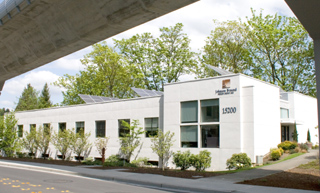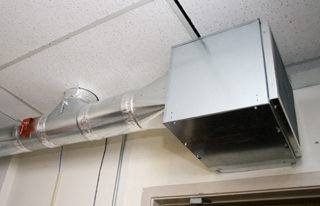
Surveys
DJC.COM
June 26, 2008
Architectural firm sets a zero-energy goal
Johnson Braund Design Group

Allwine
|
Zero energy consumption isn’t a new idea, but what is new are the technologies and practices that make that goal within reach and budget. Over the past two years it’s been my task to reduce the environmental impact and electrical consumption at Johnson Braund Design Group.
The ultimate goal, much to the chagrin of our utility, is to generate all the energy our office consumes. To reach this goal, I started with an easy milestone: a 50 percent reduction in our electrical consumption within one year.
Where to start
The question is “Where to start?” Depending on your facilities, it’s smart to focus on three areas: conservation, heating/cooling systems and lighting. Our offices are located in a two-story, 8,000-square-foot wood-frame office building that was built in the 1980s with lots of glass.

Johnson Braund installed solar panels in November 2007 on the roof of its Tukwila headquarters. |
What made our decision to upgrade was simple. Our 20-year-old forced-air electric heating system on the rooftop was beginning to fail. This presented a great opportunity to replace an extremely inefficient system with new energy-conscious technology. Working with a major HVAC manufacturer, we were given the opportunity to commission a state-of-the-art efficient heat-pump system.
With Seattle’s mild climate, our heat pumps would work well year round. As the temperature dips below 40 degrees, our supplemental propane kicks in to boost the temperature. If we choose, we can also heat with natural gas as a fuel.
The new HVAC system has increased our indoor air quality by allowing us to frequently refresh and constantly filter the air within the building.
Found opportunities
The new HVAC system led to another opportunity in our server room. Our eight rack-mounted servers generate nearly 9,000 Btu of waste heat each hour. That’s a lot of heat. Previously, a dedicated air-conditioning system operated 24/7 in that room, even if it were snowing outside. For most of the year, our employee entrance was perpetually chilly.

Hot air is ducted from the server room to heat an employee entrance. During the summer, the duct is switched to blow the air outside. |
Working with our contractor, we eliminated two problems at once. By installing a dedicated low-watt fan and ducting from our sauna-like server room to the rear entrance, we are now able to shut off that AC unit, and keep our employee entrance much warmer. During the warmer summer months, the ducting is manually switched to vent the waste heat directly outside, which reduces our cooling loads.
Sunshine power
With our goal of net-zero energy consumption, in addition to conservation improvements, we need to generate our own onsite power. With the removal of our old heating system, and an open rooftop, we had 4,000 square feet of roof to construct a solar array. Conservatively, we were able to install 48 solar panels, tilted at the correct angle towards the sun. Those panels produce up to 10 kilowatts of peak electricity per hour, which yields as much as 10 megawatt hours of electricity annually.
Working with Western Washington Solar, we installed those panels in November 2007 with two grid-tie inverters and a large battery backup. The batteries allow us to operate essential business functions even during prolonged power outages. And as every business owner knows, time is money.
Just two years ago, our offices were without power for more than a week due to a weather-related outage. In that situation alone, the array and its battery backup would have paid for itself by allowing us to access our vital information on the servers, keeping our 25-person design firm productive.
Today, there are several resources available to help businesses invest in conservation improvements and renewable energy generation solutions. First, a 30 percent federal tax credit of the installed cost of solar panels, with no upper limit for business, is available. All solar equipment is currently sales tax free in Washington state, and the state offers solar power production credits of up to $2,000 annually.
Many utilities help with the cost of solar equipment in the form of rebates and/or grants. An installed array is also eligible for accelerated depreciation, saving more money for our company. Most solar panels are warranted to last at least 30 years. Over that time period, our business will save $30,000 in electrical costs at today’s rates.
We estimate a 10-year payback on our solar investment. Since it will last for at least 30 years, it essentially works out that we are prepaying our electrical bill for a decade at today’s rates and in return will receive two decades of “free” electricity. With the current rebates and credits in place, it is amazing that every business or building owner in Seattle doesn’t rush out and install solar power.
Roadblocks
| Small changes, big savings |
|
In addition to the major improvements, Johnson Braund was able to achieve substantial reductions in its electrical consumption with the following conservation investments:
• Each person’s desktop task lighting was replaced with CFLs, saving 100 kilowatts monthly. • In the restrooms, switch-mounted occupancy sensors were installed, saving 25 kilowatts. • Copiers were plugged into switch-mounted timers that shut them off automatically at night, saving 72 kilowatts. • Two 24-hour security lights were replaced with LED lighting, saving 115 kilowatts. The upgrades cost around $400, but are saving nearly $700 a year. |
Surprisingly, the largest roadblock we faced in our efforts came from Seattle City Light. Before we began our energy conservation effort, we were told by a City Light conservation expert we had essentially installed all the recommended cost-effective conservation improvements to the building.
When I discussed our plans for onsite solar with the City Light expert, he said, “We see private customer electrical generation as competition, and we don’t support it for private ventures.”
City Light was unwilling to offer any financial support or incentives for any portion of our solar project. Unlike other regional utilities, City Light does not have any financial rebates or credits for private solar projects.
Additionally, City Light initially said it would support a majority of the cost for our efficient heating and cooling upgrade. However, once it learned that a portion of our heating during the coldest months was from propane, it cut our rebate to a fraction of the initial quote.
We proceeded with our hybrid heating system, as it yields the least impact on our energy-consumption footprint. Had Seattle City Light provided gas to our location, we would not have had to switch and the utility would have provided the rebates and credits for our new HVAC system.
Contact your utility about what programs it offers before starting your energy-conservation improvements. Most of the utilities have good information, resources and programs available. It is important you do your homework as you may find that a minor change in your system, even though it may increase your efficiency, can disqualify you from rebates or credits. In our case, as a design firm, it was time to walk-the-talk and invest in the future.
The future
Since this time last year, we have reduced our electrical power consumption by 49.2 percent. To achieve the second part of our goal to reduce our consumption by another 50 percent, we are considering a more advanced lighting system that uses cubicle occupancy and day-lighting sensors to control lighting levels. We are also switching our desktop computers to power miser laptop systems, saving 125 watts per computer, per hour. Additionally, by using virtualization server software, we’ll be able to cut the number of servers by 75 percent, saving 2,000 watts each hour.
With these changes, we will be very close to achieving our goal of producing more power than we consume. Not bad for a 23-year-old building in perpetually rainy Seattle.
Steve Allwine is Johnson Braund Design Group’s marketing coordinator and IT director. He serves as treasurer for the regional board of the National Academy of Television Arts & Sciences and is active in testing sustainable design practices within his firm.
Other Stories:
- Corporate social responsibility turns green
- A green approach to gold mining in the Okanogan
- Financing evolves to benefit the environment
- Homeowners rethink their waterfronts
- Will Earthships save the Earth?
- Municipalities discover the benefits of eco-roofs
- What lies ahead for sustainable design?
- Planning our communities for a low-carbon future
- City, tribe team up on clean water project
- New stormwater discharge challenges loom
- Green building’s future lies in innovation, conservation
- Seattle becomes a hotbed for clean technologies
- Speed up sustainable development with a planned-action EIS
- Avoiding fish-related construction delays
Copyright ©2009 Seattle Daily Journal and DJC.COM.
Comments? Questions? Contact us.